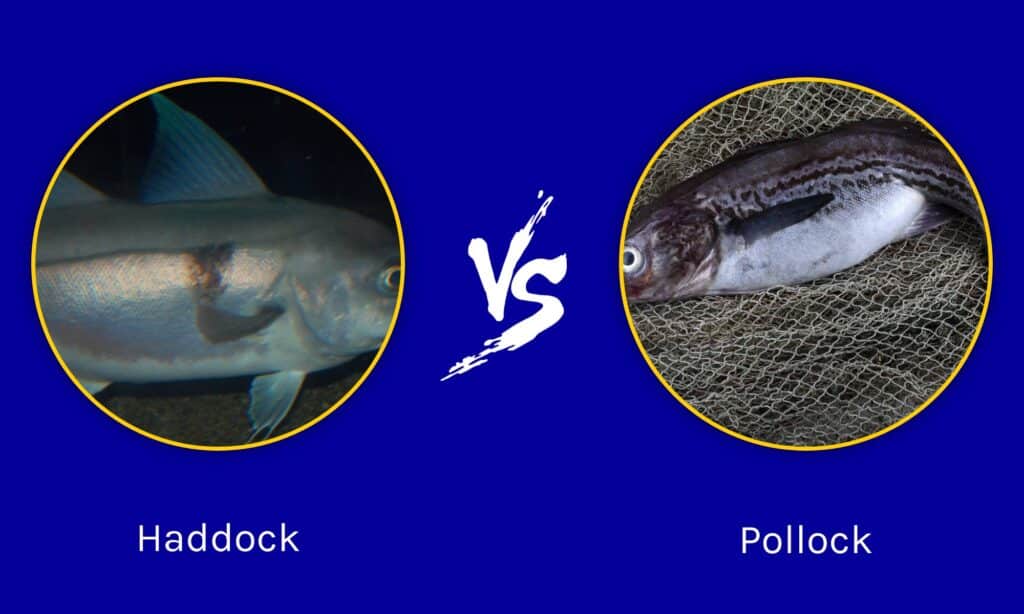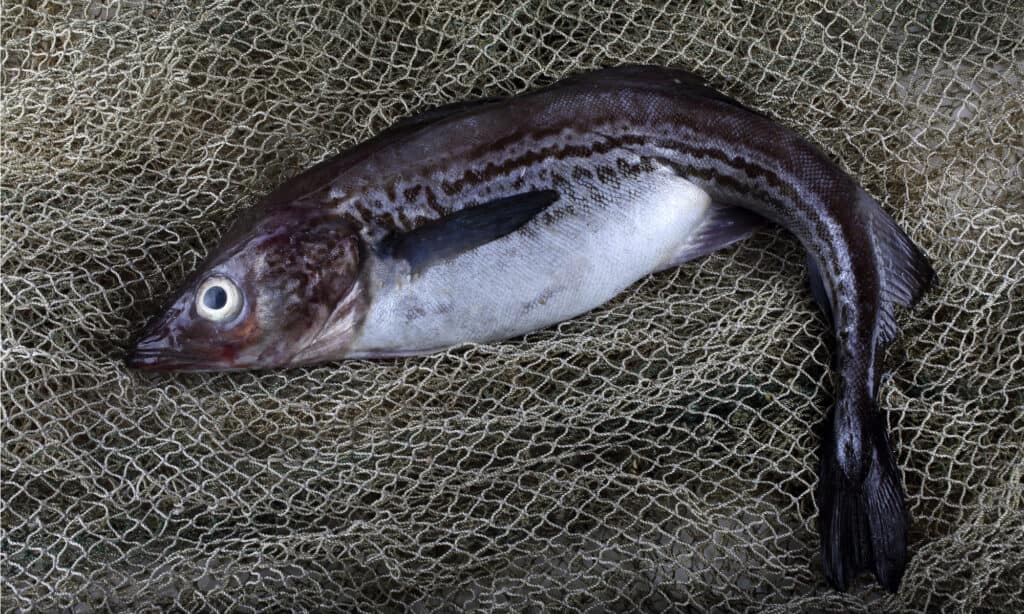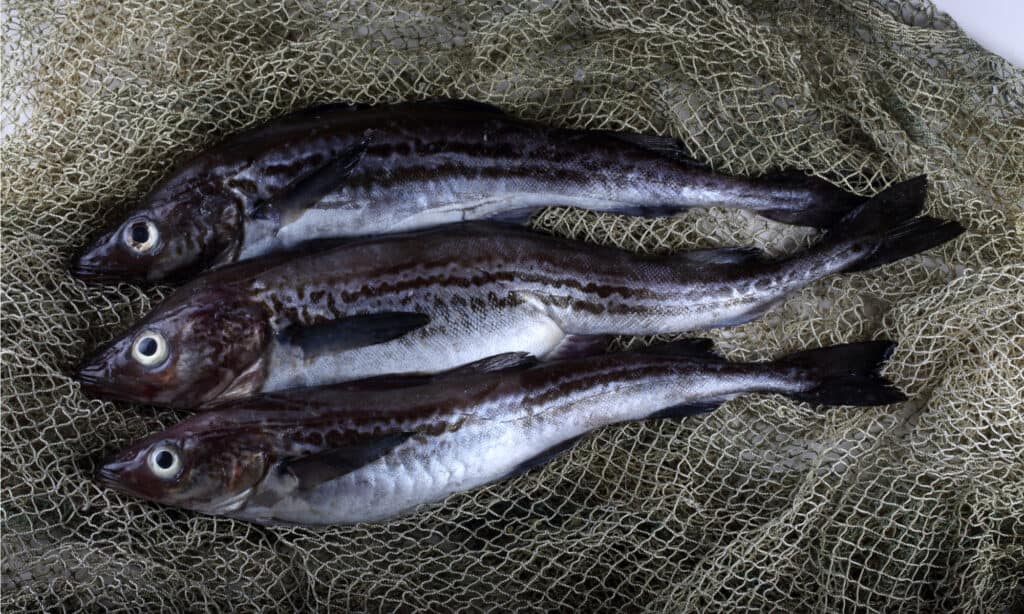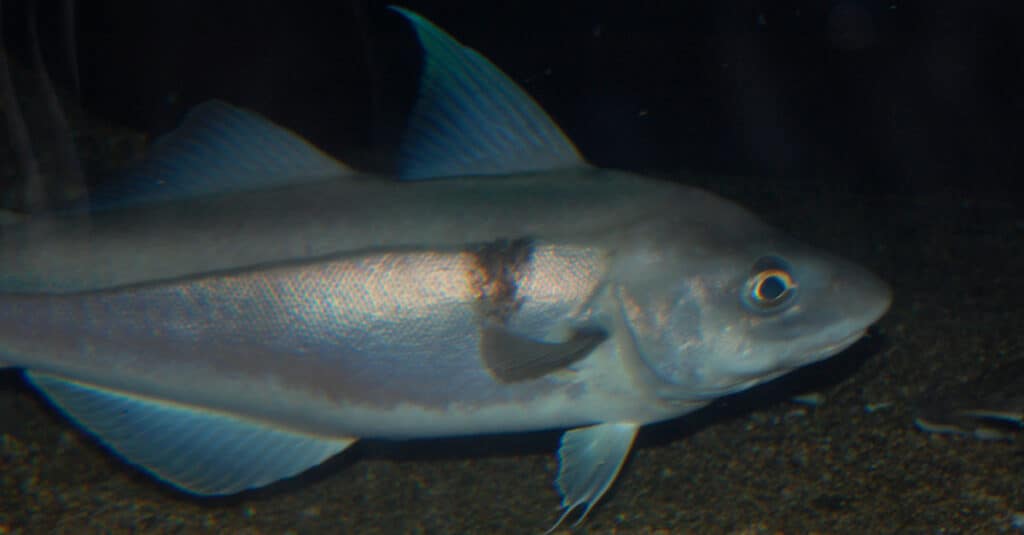Alaska pollock and haddock are closely related fishes. They are popular whitefish species known across the world. They both belong to the same family of true codfish known as Gadidae.
Haddock fish is classified under a genus called Melanogrammus and has only one species (M. aeglefinus). On the other hand, Alaska pollock belongs to a genus known as Gadus, with three other cod species. The other three members of the Gadus genus are the Pacific cod, Atlantic cod, and Greenland cod.
No matter how much haddock and Alaska pollock have in common, they are not the same, and their differences are notable. This article compares both animals to see how we can know them more distinctly.
Comparing Haddock vs. Alaska Pollock

| Key Features | Haddock | Alaska Pollock |
|---|---|---|
| Size | – Length 1–3 ft (30 – 91 cm) – Weight 2–40 lbs (0.9 – 18.14 kg) | – Length 1–3 ft (30 – 91 cm) – Weight 1–3 lbs (0.45 – 1.36 kg) |
| Appearance | – Elongated, tampering body shape with a small mouth and a wedged-shaped profile. – Dark scales on the upper body and lighter scales on the side. – has a dark or purplish lateral line and a distinctive dark spot on both sides. | – Elongated torpedo-like body shape – Strongly defined dark grey to silvery scales on the side. – Silvery lateral line running down the sides. |
| Habitat | On or near the bottom of lakes and seas up to 1,400 ft | On or near the bottom of lakes and seas up to 1,000 ft |
| Prey | Sand eels, Gobies, European sprat, and Atlantic herring | Fish caviar, Small fishes, Small crustaceans, and Zooplanktons |
| Reproduction | Gestational (1-3 weeks) | Gestational (1-2 weeks) |
| Diets | Carnivore | Carnivore |
| Lifespan | 10 years or more | 12 – 28 years |
6 Key Differences Between Haddock and Alaska Pollock
Haddock and Alaska pollock are both popular fish species known in different parts of the world. Sometimes we might want to confuse one for the other. The two species of fish differ in size, appearance, habitat, range, taxonomy, and conservation status.
Let’s explore salient details vital in telling these animals apart!
Haddock vs. Alaska Pollock: Size

Haddock measure between 1 and 3 feet in length.
©Piotr Wawrzyniuk/Shutterstock.com
Haddock and Alaska pollock have varying sizes and weights. Haddock measure between 1 and 3 feet in length. The average weight of a haddock is between 2 and 40 lbs. Haddocks grow rapidly every year. They can measure between 6.5 to 7.5 inches the first year and double in size the following year.
Alaska Pollock can grow up to 3 ft, although the average Alaska pollock size is 12–20 inches long. Its average size is 1 to 3 pounds.
Haddock vs. Alaska Pollock: Physical Features

Alaska pollocks have anal spines and a small chin barbel and are slightly pale on their ventral sides.
©Alex Coan/Shutterstock.com
The easiest way to differentiate between haddock and Alaska pollock fish is through their outward appearance. They both have distinct external features that are notable.
Haddocks are known for their black lateral line that runs along their white side. They also have a distinctive dark blotch above the pectoral fin that is popularly called the “thumbprint,” “Devil’s thumbprint,” or “St. Peter’s mark.” The upper side of their body varies in color from dark grey-brown to nearly black, while the lower part of the body is a dull silvery white shimmer.
Alaska Pollocks can be distinguished by their greenish coloring and white lateral line. They have anal spines, a small chin barbel, and are slightly pale on their ventral sides.
Haddock vs. Alaska Pollock: Habitat

Alaska pollocks are found in the northern Atlantic Ocean.
©Alex Coan/Shutterstock.com
Haddock fish are saltwater dwellers. They reside on either side of the Atlantic Ocean but can be found mainly on the northern Atlantic Ocean, coasts of Europe, western Atlantic, and eastern Atlantic bordering North America. Haddock has a far-reaching range from the coast of North Carolina to the coast of Canada. Like other aquatic organisms, climate change has an effect on the distribution of haddock.
Alaska Pollocks are found in the northern Atlantic Ocean. They love cold, clean, and pristine waters filled with zooplankton. For the first 6 months, Alaska pollocks are pelagic and live close to the surface of the ocean or around gulfs. They increase in depth as their size and age increase. While young pollock inhabit the intertidal zones, the adult pollock live in the pelagic region and can be seen at different levels of the Atlantic Ocean.
Haddock vs. Alaska Pollock: Range
Haddock and Alaska pollock are both demersal. They live deep down the ocean, close to the seabed. Although a large species of haddock lives within a depth of 260 ft, it can survive at a depth of 1,400 ft below the ocean’s surface.
On the other hand, matured pollocks swim to a depth of 1,000 ft below the surface of the water. Their range varies with their maturity. Younger pollock live near the surface under rocks and see weeds to hide from predators.
Haddock vs. Alaska Pollock: Taxonomy

Haddock belong to the genus
Melanogrammus.
©Steven G. Johnson / CC BY-SA 3.0 – License
Haddock and Alaska pollock both belong to the family Gadidae but are of different genera. While haddock belongs to the genus Melanogrammus, Alaska pollock belong to Gadus.
Haddocks are known scientifically as Melanogrammus aeglefinus, a combination of both the genus and species.
Alaska Pollocks are known scientifically as Gadus chalcogrammus. Because of their habitat and consumption in different parts of the globe, Alaska pollocks are known by different names and nicknames. They include:
- Pollock
- Walleye pollock
- Snow cod
- Big eye cod
Haddock vs. Alaska Pollock: Conservation status
The assessment conducted by the International Union for Conservation of Nature (IUCN) on haddock in 1996 shows that this famous saltwater dweller is a vulnerable species. The IUCN classified the Alaska pollock as a near-threatened species in an October 2013 assessment.
There is a continuing decline in the population of both haddock and Alaska pollock because of their numerous predators.
The photo featured at the top of this post is © Alex Coan/Shutterstock.com
Thank you for reading! Have some feedback for us? Contact the AZ Animals editorial team.







